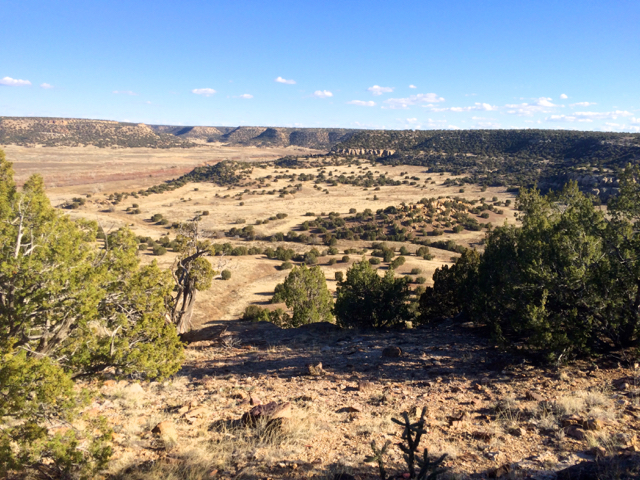We all know the Great Plains for their wide and open spaces. With little to hinder the eye – no peaks, no forests, only rolling hills and sometimes not even that — we can see far and deep. Thunderstorms a county or two over boil up before us by day, stars are seen horizon to horizon at night.
We are all Einsteinians, and so know that when we look deep into space we are looking deep into time, as space and time are woven together into a seamless continuum. That’s obviously true of the sky, where light from the nearest stars was emitted years ago.
But the plains are a place where time reveals itself to us in Earthly forms as well. With no place to hide, the signs of our predecessors are all around. Some segments of the Great Plains Trail take us through time as well as space.
The canyon of the Purgatoire – or as it is more commonly known in Colorado, the Picketwire — is one of these places. The Picketwire itself rises on the Raton Mesa at the NM-CO border, and flows some 120 miles northeast to its junction with the Arkansas at Las Animas.
Along the way it cuts a canyon a few hundred feet deep. Although not as scenic or spectacular as Palo Duro Canyon in the Texas Panhandle, it harbors its own hidden treasures which are revealed in a pleasant walk up or down the canyon.

From the car campground at Withers Canyon Trailhead, you drop 250 feet and begin your walk up the canyon. A couple of miles of easy walking brings you to the remains of an outbuilding of the Rourke Ranch, in operation from 1871 to 1971.
Another mile or so of walking takes us back considerably farther in time to 1,500 year old petroglyphs etched into the rocks at the base of a river bluff.


A bit more walking takes you to the ruins of an old church and its graveyard. Judging from the names and dates, this was a Hispanic settlement that must have existed at least since the first half of the 19th century.


These settlers would have been cut off from the main Spanish settlements in the Rio Grande Valley by several mountain ranges. They probably had only Bent’s Fort as their link to the outside world, and were otherwise utterly isolated, vulnerable to raids, drought and disease with no outside assistance. It had to be an incredibly harsh life.
A couple more miles and you are at the dinosaur trackway, the longest and most extensive set of tracks in North America. Set on a mudstone shelf, these tracks take you all the way back to the Late Jurassic Era 150 million years ago. Over 1300 footprints have been tallied, and it doesn’t take too much imagination to see therapods and brachiopods loping and lumbering across the valley.




These tracks are in soft stone and are completely open to the weather. Chunks of the shelf are constantly breaking off and tumbling into the river. My advice: come take this hike while the tracks are still here. They are never going to get any better, and a flood could wipe them all away at any time.
If you are car camping, it is time now to turn back for a delicious dinner…

… followed by a beautiful Great Plains sunset

The Picketwire Canyon, despite being a delightful hike, is currently a side trip on the Great Plains Trail. It is our goal to someday route the main trail through this canyon. How can I make this happen, you ask? A donation to the GPTA will help us do the work of contacting landowners and obtaining easements that will move the trail off of country roads and into the wild. Click here and give generously.


3 Responses
I’ve only traversed it on the highway, and wasn’t aware you could visit it. I have hiked and explored about the canyons along the CO-OK border near Kenton, and it has quite the look of dry parts of the Texas Hill Country including some plants only found there in CO. I wonder if Picketwire has some of the same unique flora?
I’m no expert botanist, but as I recall, Picketwire is more juniper and less oak than the areas you’re talking about. That said, it’s a great spot and well worth checking out the next time you’re in the area.
Excellent blog post: Those pictures are phenomenal!!